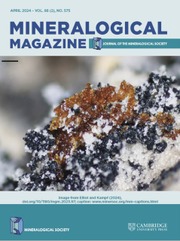Crossref Citations
This article has been cited by the following publications. This list is generated based on data provided by
Crossref.
Li, Jie
Hadidiacos, Chris
Mao, Ho-Kwang
Fei, Yingwei
and
Hemley, Russell J.
2003.
Behavior of thermocouples under high pressure in a multi-anvil apparatus.
High Pressure Research,
Vol. 23,
Issue. 4,
p.
389.
OHTAKA, Osamu
UTSUMI, Wataru
and
KIKEGAWA, Takumi
2004.
High-Pressure Apparatus for In Situ Neutron Diffraction Experiments.
The Review of High Pressure Science and Technology,
Vol. 14,
Issue. 2,
p.
151.
KAGI, Hiroyuki
2004.
Neutron Diffraction Measurements at High Pressure at ISIS, UK.
The Review of High Pressure Science and Technology,
Vol. 14,
Issue. 2,
p.
143.
Bennington, S. M.
2004.
The use of neutron scattering in the study of ceramics.
Journal of Materials Science,
Vol. 39,
Issue. 22,
p.
6757.
NAGAI, Takaya
and
KAGI, Hiroyuki
2004.
Intense pulsed neutron sources open a new window of mineralogy.
Japanese Magazine of Mineralogical and Petrological Sciences,
Vol. 33,
Issue. 2,
p.
62.
Zhao, Yusheng
He, Duanwei
Qian, Jiang
Pantea, Cristian
Lokshin, Konstantin A.
Zhang, Jianzhong
and
Daemen, Luke L.
2005.
Advances in High-Pressure Technology for Geophysical Applications.
p.
461.
Stone, H. J.
Tucker, M. G.
Meducin, F. M.
Dove, M. T.
Redfern, S. A. T.
Le Godec, Y.
and
Marshall, W. G.
2005.
Temperature measurement in a Paris-Edinburgh cell by neutron resonance spectroscopy.
Journal of Applied Physics,
Vol. 98,
Issue. 6,
Yuan, V. W.
Bowman, J. David
Funk, D. J.
Morgan, G. L.
Rabie, R. L.
Ragan, C. E.
Quintana, J. P.
and
Stacy, H. L.
2005.
Shock Temperature Measurement Using Neutron Resonance Spectroscopy.
Physical Review Letters,
Vol. 94,
Issue. 12,
Stone, H.J.
Tucker, M.G.
Le Godec, Y.
Méducin, F.M.
Cope, E.R.
Hayward, S.A.
Ferlat, G.P.J.
Marshall, W.G.
Manolopoulos, S.
Redfern, S.A.T.
and
Dove, M.T.
2005.
Remote determination of sample temperature by neutron resonance spectroscopy.
Nuclear Instruments and Methods in Physics Research Section A: Accelerators, Spectrometers, Detectors and Associated Equipment,
Vol. 547,
Issue. 2-3,
p.
601.
Harrison, Richard J.
Stone, Howard J.
and
Redfern, Simon A.T.
2006.
Pressure dependence of Fe–Ti order in the ilmenite–hematite solid solution: Implications for the origin of lower crustal magnetization.
Physics of the Earth and Planetary Interiors,
Vol. 154,
Issue. 3-4,
p.
266.
Saxena, Surendra K.
and
Wang, Yanbin
2007.
Methods for Phase Diagram Determination.
p.
412.
Wood, Peter A.
Francis, Duncan
Marshall, William G.
Moggach, Stephen A.
Parsons, Simon
Pidcock, Elna
and
Rohl, Andrew L.
2008.
A study of the high-pressure polymorphs of L-serine using ab initio structures and PIXEL calculations.
CrystEngComm,
Vol. 10,
Issue. 9,
p.
1154.
Moggach, Stephen A.
Parsons, Simon
and
Wood, Peter A.
2008.
High-pressure polymorphism in amino acids.
Crystallography Reviews,
Vol. 14,
Issue. 2,
p.
143.
Principi, Emiliano
and
Cicco, Andrea Di
2008.
Development of an experimental set-up for electroresistance measurements of materials under high pressure and temperature.
Measurement Science and Technology,
Vol. 19,
Issue. 9,
p.
095701.
Johnstone, Russell D. L.
Francis, Duncan
Lennie, Alistair R.
Marshall, William G.
Moggach, Stephen A.
Parsons, Simon
Pidcock, Elna
and
Warren, John E.
2008.
High-pressure polymorphism in L-serine monohydrate: identification of driving forces in high pressure phase transitions and possible implications for pressure-induced protein denaturation.
CrystEngComm,
Vol. 10,
Issue. 12,
p.
1758.
Redfern, Simon A.T.
and
Harrison, Richard J.
2009.
Neutron Applications in Earth, Energy and Environmental Sciences.
p.
107.
Bromiley, Geoffrey D.
Redfern, Simon A.T.
Le Godec, Yann
Hamel, Gérard
and
Klotz, Stefan
2009.
A portable high-pressure stress cell based on the V7 Paris–Edinburgh apparatus.
High Pressure Research,
Vol. 29,
Issue. 2,
p.
306.
Fang, Hong
Gu, Mu
Liu, Bo
Liu, Xiaolin
Huang, Shiming
Ni, Chen
Li, Zeren
and
Wang, Rongbo
2009.
A modified area function in time scale for the transmission data analysis of neutron resonance.
Nuclear Instruments and Methods in Physics Research Section B: Beam Interactions with Materials and Atoms,
Vol. 267,
Issue. 23-24,
p.
3663.
Moser, D.
Bull, D. J.
Cowpe, J. S.
Roach, D. L.
Ross, D. K.
Noréus, D.
and
Tucker, M. G.
2010.
Anin situneutron diffraction measurement of the pressure–temperature evolution of a MgD2:TiD2mixture.
High Pressure Research,
Vol. 30,
Issue. 4,
p.
643.
KOMATSU, Kazuki
2010.
Neutron Diffraction Under High Pressure and High Temperature.
RADIOISOTOPES,
Vol. 59,
Issue. 9,
p.
571.

